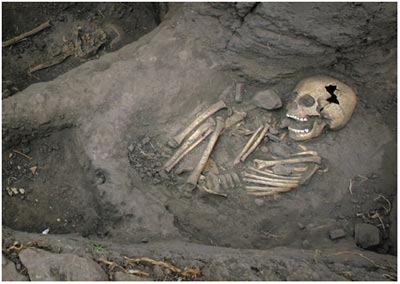Monuments of 1,000 unique ancient tombs in Colombia
Construction workers cleaning up the land of a residential project in Colombia have discovered an ancient graveyard containing nearly 1,000 graves related to two little-known civilizations.
The area occupies about 5 hectares in the poor Usme district in southeastern Bogotá and includes a group of relics that researchers believe may be victims of human sacrifice. According to Ana Maria Groot, one of the main anthropologists of the National University of Colombia working in the area, the victim - a young woman - seems to have been buried alive.
'Her mouth opened wide as if she was frightened and her hands folded as if she was trying to hold something.'
Another grave contains the remains of a man with a curved tibia, a possible proof that he is a magician. Spanish observers in the 1500s wrote about native mages spending very long time in caves without exposure to the sun. According to Virgilio Becerra, Groot's partner, lack of sunlight will cause a lack of vitamin D, bending the bones.

A set of remains revealed from the land of an ancient tomb, one of thousands of tombs recently discovered in a land in Bogotá, Colombia.(Photo: Fernando Vergara / AP)
Two mysterious cultures
Besides these unusual findings, this area is unique in its chronology and residence time. The tombs date from the first century to the 16th century AD , based on analysis of pottery discovered with human remains.
The region's first 500 years of use belonged to the era called Herrera , when anonymous small groups developed in the Andean plateau during the agricultural development period.
'Agriculture has become more intensive and systematic around this time. We hope to find out what kind of plants they cultivate. '
Around 500 to 1500 AD, the area seemed to be occupied by the Muisca people, another of Colombia's most important but least well-known cultures. With many relics from both periods, the Usme area is a potential source of valuable information.
'A settlement area such as Usme provides an opportunity to study the development of settlements through various stages with prolonged residence.'
"The progress of the analysis is likely to reveal more about the age, diet, disease and other areas of daily life and the social structure of the settlements ," Groot added.
Temple area and other findings
Anthropologists also discovered remnants of a settlement close to the burial area, including evidence of a temple. Piles show that the temple has a rather large circular structure.
Pottery discovered together with bone relics largely consists of simple bottles of decorative water bottles, cooking pots and cup cups. Decorative water bottles combine geometric structure with images of animals such as frogs, birds and snakes.
The researchers also found stones used to cut vegetables and to crush seeds, although there is no evidence of the diet of settlers.
Local authorities are considering turning this place into a museum.
Excavation began in January and will continue while anthropologists wait for results from radioactive carbon samples of human bones and other objects to date them.

Anthropologists also discovered remnants of a settlement close to the burial area, including evidence of a temple.(Photo: Fernando Vergara / AP)
Discovering 'priceless'
Guillermo Cock is an Andean archaeologist and expert. He cautioned that clear evidence of the secularity of people obtained in Usme may have other causes.
In the case of a young woman who seems to be buried alive, her folded hand can be explained by early rheumatism. Similarly, her open jaw may result from the removal of the body before or after burial.
However, the region of Usme can prove 'invaluable' to science. Cock helped unearth burial areas with thousands of graves in Peru.
Cock said 'Preserving graves and other archaeological evidence in Colombia and Venezuela tends to be quite poor because of the moisture content of the soil, which quickly destroys organic ruins. If each grave's period is determined, even if they are in a state of severe deterioration, it will provide invaluable information about Muisca residents. '
- Decode huge ancient tombs of 2000 year old stone
- The secret of the ancient tombs was unearthed in Vietnam
- Ancient tombs of thousands of years carry the form of 'dead boat'
- Khai excavated an ancient tomb for 300 years in Hanoi
- 6000 year old grave is the first telescope in the world?
- Discovered 600 ancient tombs dating back thousands of years
- Rare discovery: Ancient tombs are found immediately in the famous Chinese university campus
- Digging the school yard, accidentally 'opening' the 1,300-year-old ancient tomb
- Many unique features in Cao Phuong ancient tomb
- Mysterious mummies in Vietnam
- Discover two intact ancient tombs in southern Greece
- Again discovered the ancient tomb at Ciputra
 Discovered an ancient centipede fossil 99 million years old
Discovered an ancient centipede fossil 99 million years old Discovered bat-like dinosaurs in China
Discovered bat-like dinosaurs in China Discovered a 200-year-old bronze cannon of the coast
Discovered a 200-year-old bronze cannon of the coast Discover 305 million-year-old spider fossils
Discover 305 million-year-old spider fossils